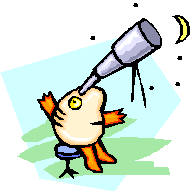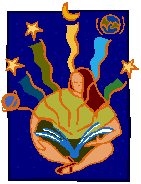
Tips for Holding a Viewing Night
Introduction
One of the problems faced in teaching astronomy is that you are generally discussing objects that cannot be seen during a typical school day. Whilst there are now some schemes that allow you to access telescopes remotely so that your class can view night somewhere else in the world, there is still nothing to beat the impact of a well-run viewing night under clear dark skies to promote an interest in many students. This article provides you with some tips and guidelines in how to hold a successful event.
Preparation
The better prepared you are prior to the night the more likely it will run smoothly. A major concern teachers have in deciding whether to hold a viewing night is the problem of lack of telescopes.
Telescopes

Many schools may have an old telescope buried away in a corner of the Science storeroom that has been unused for years. Even if you do have one in working order you may not know how to use it. Fortunately there are several steps you can take to remedy the situation.
- Ask if students/parents/staff have their own telescopes. A simple item in the school newsletter or on Assembly may unearth keen amateurs within your school community.
- Contact your local amateur astronomy club. Many amateur clubs are only too keen to help out with school visits. The key here is to contact them early enough for them to arrange some telescopes and members. They can act as the “experts” in showing students specific objects and are generally passionate about their hobby. Whilst some do not seek it, a donation to their club funds would always be appreciated and is cheaper than buying a telescope! To find if you have a local club and how to contact them, magazines such as Sky & Space have a list of clubs. The Australian Astronomy website has a list of clubs online at with links.
- Buy a telescope. Useful telescopes have dropped dramatically in price over the last couple of years. A 20cm Dobsonian can be bought new for $600 whilst easy to use computer-controlled telescopes such as the Meade ETX125 can be purchased for around $1750 and up. One possibility in holding a viewing night for the school community is to ask for donations to raise funds to purchase a telescope for subsequent events. Another option is to approach the P&C or other fund raising groups within the school.
- Make a telescope. This would make an engaging project for a school astronomy club or keen students. The complexity would depend on skill and experience but practical and effective telescopes can be assembled using ready-made optics and other components. Some students could even design their own as part of a D&T project.
- Use binoculars. It is still possible to conduct a viewing evening without a telescope, albeit perhaps less engaging for most students. Even if you have some telescopes encourage participants to bring along and use binoculars. They are very effective for wide-field views. Money is better spent on a decent pair of binoculars than a cheap department store telescope. Binoculars are even more effective if you can mount them on a video or camera tripod.

Purpose
You should try and be clear as to the purpose of the viewing night. Is it a promotional event for the Science department? Is it a regular feature of an astronomy club? Are your students expected to fulfil some syllabus or program requirement? Do they have to complete the dreaded worksheet?!!! Be clear in both your aim and expected and desired outcomes for the evening. Avoid the temptation to try and do too much or cater for too many diverse groups. Make your purpose explicit to those involved.
If you have specific objects that you wish to observe on the night, make a list of them. Check which ones are likely to be up first and which ones will set first or rise late. Prepare a checklist of objects in observing sequence if time is going to be critical.
Date
This can of crucial importance. If you are trying to introduce a Year 7 class to the Solar System ensure that the Moon is visible in the evening sky and some planets are up. On the other hand if you are trying to observe some deep sky objects with your Year 12 Physics class you want to avoid full moon. Check what time the Sun sets and twilight ends. Make sure you have sufficient length of dark skies to achieve your objectives.
When you start trying to identify possible nights you may find it frustrating trying to arrange the appropriate date with all the other conflicting demands on students, you and the available facilities. Use books such as Sydney Observatory Sky Guide or Astronomy 2004 by Quasar Publishing to help you select suitable dates. There are several online tools that can also help that are listed in the appendix. Many popular astronomy magazines such as Sky & Space, Astronomy and Sky & Telescope include southern sky charts and calendars of upcoming celestial events to help you plan.
Location, Location...

Your location can make or break your viewing night. You should try and visit it at night under similar conditions and time to your planned event. Check for lights and the field of view. If you have security lights can they be overridden? Lighting can be handy in helping you set up and the ability to light up an area at the end can be effective in giving people the message to go home but there is nothing worse than lights and light pollution to ruin the impact of looking through a telescope.
Check that our planned location is safe. Remember IT WILL BE DARK! Your location should be smooth underfoot – you do not want your students tripping over and injuring themselves or damaging a telescope.
If you are using computer-controlled telescopes can you access electricity from the site? Where will you run the power cords?
Notification
Each school has its procedures for external and internal excursions. Ensure you discuss your plans early and thoroughly with other relevant staff and you obtain all the required clearances. You may and should complete some form of risk assessment. Obtain contact details in case of accident or illness among participants.
When notifying students and seeking parental permission make sure the timings for the event are clear. You do not want students waiting around after the event to be picked up. Identify where students will be gathered.
Ensure that matters such as dinner are sorted out and everyone knows if is included or whether to eat before the event. As viewing nights are always subject to the vagaries of weather it would be wise to have your cloudy/wet weather alternatives clearly stated on the notification form. If there is a cut-off time for cancelling the event make this clear and stick to it. If possible provide a contact number for parents or check that students have access to a mobile phone or pay phone onsite.
Your notification should also list appropriate equipment and dress required by participants. Sandals and skimpy tee shirts are not practical for a winter viewing night.
Star Charts and other Handouts.
If possible try and ensure you have a number of star charts or even star wheels to use on the night. There are several sources of free star charts that you can access from the web (see Useful Resources below). The popular astronomy magazines also have star charts included each month. Star wheels are an excellent resource and are available in a variety of forms. The ABC shop sells a useful large one though you may prefer the Philips or blue and white “The Night Sky” star wheels, both of which are laminated for durability and moisture-resistance.

On the Night
You have prepared for the event and the weather is kind with clear skies. Your eager and expectant students are looking forward to a memorable evening. How can you make it run smoothly?
Assembling and Setting Up
If you have clearly identified a meeting time and place then make sure you are there ahead of time. Once the students are gathered, check attendance and brief them as to expectations, behaviour and the bounds for the night. You should have a clear range around which students can move and clear out-of-bounds areas. Students should move around in pairs or larger groups for safety. If you need to set up equipment get the students to help. If you have particularly heavy, fragile or expensive equipment it is probably best if you handle them – if a student drops the school telescope it makes it even worse for everyone.
Once at your observing location, designate waiting and general viewing areas; where the telescopes will be, how to approach them and how to move away. It is vital that you stress the importance of no clowning around near the telescopes. If students are expected to carry out work tasks you may wish to set up some tables or a designated workspace. Ensure all electrical cables are secured and safe. Remember if may get damp as the night progresses so ensure they are protected from dew.
Depending on the type of telescope you may need to align it with the south celestial pole as best as possible. Even for telescopes such as Dobsonians it is important to site them on firm level ground. Check the alignment of finder scopes with the main telescope field of view and realign if necessary. This works best with distant objects on the horizon, the further the better. You may also need to check the collimation of reflecting telescopes and recollimate if needed. All these procedures can form part of the instructional sequence for students for the night.
Given that you are likely to have many more students than telescopes or even binoculars it is handy to have some banana lounges or groundsheets/blankets that students can lie down on and gaze up at the sky. The rubberised picnic blankets are excellent for this purpose as they are dew-resistant and comfortable. Students may even bring blankets or sleeping bags to keep warm in. Be aware that dark cold nights and students huddled together under blankets can have a dramatic effect on adolescents and lead to romance so you may need to be vigilant.
Make sure all students cover their torches in red cellophane so that the light has less effect on their night vision.
Evening

This is often the best part of a viewing evening and one overlooked by many. If you have the time, make sure everything is set up in the daylight and students are relaxed, fed and comfortable. By starting your viewing night at dusk you can introduce students to the bright evening objects and highlight the changes that occur in visibility. Discuss twilight and colour. As the available light fades they should lose their ability to see in colour. You can relate this to sensitivity and give a quick talk on the structure of the retina if you like. This is a good time to raise the issue of light discipline for later in the night, i.e. no shining of torches in people’s eyes.
If you have a clear western horizon you may find Venus or even Mercury low in the sky at dusk. Probe your students as to why they are found there (or in the eastern dawn sky). If you are observing up to a first quarter Moon you should have a clear view of it in the western sky too. You can start observing this through a telescope long before stars are visible. Ask students to relate the illumination of the Moon to the Sun’s position.
As the stars appear, ask students if they can identify any of them. Ask them to try and fix the position of a few stars relative to the horizon or landmarks. You can then refer back to this an hour or more later so that students can see that the stars appear to have moved. If you wish to, ask them to estimate what angle they have moved through and see if they can relate this to the rotation of the Earth. Introduce students to standard hand angle measurements (see appendix for source) to make their measurements.
Depending on the level of your students you can discuss the concept of apparent magnitude then get students to check or estimate the magnitude of stars as they become visible.
If you are in a really dark site then it is often easier to point out key constellations early when only the brightest stars are visible. Once it gets fully dark there are often so many stars it can become overwhelming and confusing for the uninitiated. Encourage students to avoid using torches unless necessary.
As the Night Progresses...

As the sky darkens encourage students to watch out for satellites. You should be able to pick up several in polar orbits moving in N/S line. If you have checked ahead using CalcSKY or other predictors such as that on the Sky & Telescope website you may be able to observe a flare from one of the Iridium satellites or observe the International Space Station (depending on your location). Using satellite-tracking software such as Orbitron you can either predict or later identify which satellites you saw.
By now you may be working your way through your observing plan. Make sure you observe objects low in the western sky first – they have a tendency to set quicker than you might think! Remind students of the protocols for approaching, using and leaving the telescopes. Despite what you might expect, the majority of students are rather timid when observing through a telescope. Encourage them to take time to adjust and get used to the eyepiece view. If the telescope is untracked then point out the movement of the object across the field of view. As you move to smaller eyepieces, the field of view decreases and the object appears to move across quicker. If necessary, adjust the pointing of the telescope to keep the object in view. With simple mounts such as a Dobsonian encourage the students to move it themselves to keep the object in view. By adjusting the focus so that the image is defocused the colour of a star is often more apparent.
The section What to Observe? provides you with other ideas on what to observe during the night. Once the night is underway try and ensure all students are engaged in some way. It can be difficult keeping track of everyone in the dark. A "buddy" system is one way of reducing the chance of students wandering off alone. Small groups can rotate around different activities, they may even be able to explain their task to the following group if you like. If it is a cold night make you check that all the students are warm enough. Spare clothing or blankets can be handy for them to use. Access to warm drinks or snacks can also help them to keep warm.
Winding Up
If you have specified a time to finish try and stick to it. Make sure your students have all had the chance to see the main objects through a telescope. Ask if any have missed out beware the telescope hog! If you have lights at your location, turning them on is always an effective way of bringing the session to a halt but please warn people first so they do not get blinded!
Give people explicit instructions as to who has to do what in packing up. Do not be caught out having to do it all yourself. Check the grounds to make sure nothing has been left behind. Ideally the students should be collected from a designated pick up spot. Hopefully everyone will be picked up on time but have contact numbers ready in case someone is running late or has forgotten – it has happened!
Bad Weather

One thing you have no control over the weather. It is as astronomer’s fear that clouds or rain will interrupt their plans. Whilst you cannot control the weather you should plan for bad weather and have a back up plan. If it is obviously atrocious weather that is going to last all night you will probably want to call your night off in plenty of time. Make sure in your original permission form you spell out the procedure for poor weather. Have a cut-off time by which students can notify parents if it is on or off. Do your students have access to a phone? How are they going to be picked up?
In a worse case the weather is marginal enough that you decide to go ahead with the night, all the students are gathered there, you have set up and then the clouds roll in…. What do you do now? Make sure you have an alternate plan. If you are at school or somewhere “civilised” you may be able to show astronomy-related documentaries or even science fiction films in a classroom. If you are in a more remote location you should still have thought through other options.
Building on Your Success
You have survived your viewing night and now have a group of keen and enthusiastic students clamouring for more! What do you do now? Many schools run successful extra or co-curricular science or astronomy clubs. These are a great means of developing student interest and expertise. They can also provide you with a bunch of keen students willing to help with any future nights.
A great website, hosted by NASA that has lots of ideas and resources is After School Astronomy Clubs. It also has an online Yahoo discussion group you can subscribe to. This group has members from several countries and is a handy and welcoming forum for those starting out and those with lots of experience.
What to Observe?
This is just a brief list of possible types of observations for students. For more detailed information, consult one of the excellent range of amateur astronomy guides from bookshops or on the web.
Naked-Eye

- Seeing and the twinkling of stars. Is there a difference between stars on the horizon and high overhead (near the zenith)? Why? Extend this to introduce the concept of seeing.
- Comparing stars and planets. Can your students distinguish between these objects?
- Locating stars and constellations. Using star charts and star wheels get your students to identify specific stars and constellations. Can they find the shapes and patterns?
- Finding your star sign. Students are likely to ask about their zodiac sign. Ask them to locate and identify it. Probe them as to what is the significance of the Zodiac? Why are there actually 13 signs?
- Creating new constellations. Ask student to create and draw their own constellations based on the stars visible.
- Aboriginal sky patterns. See if you can locate Aboriginal patterns such as the Emu in the night sky. How are their patterns different to the classical approach to constellations?
- Observing the Milky Way. Many students have never seen or been aware of the Milky Way. If holding your night in winter it will be high overhead. You can ask them to sketch its shape.
- Seeing beyond the Milky Way. How far can your students see with the unaided eye? If you have a clear dark sky they may be able to distinguish the Large and Small Magellanic Clouds, neighbouring irregular galaxies. How distant are these. You may even be able to see the Andromeda galaxy (M31 or NGC 224) low in the northern sky in late Spring.
- Meteors. This is a great activity to keep students engaged when not using a telescope. Ask them to watch out for meteors and keep a count. Try and keep a group total for a night. See if a meteor shower is predicted for your viewing night. Can you identify the constellation or quadrant from which the meteors are coming? What time of night is best?
- Satellites. Observing these is another way of keeping students engaged and observing. Works best in few hours after sunset or before dawn. Why? Do the satellites seem to follow similar paths? Why is this? Can you identify any specific satellites?
- Measuring angles. Using hands and fingers ask your students to measure angular separations of stars. How far apart are the Pointers? Does this distance change over time? How far do the stars move in an hour? Where in the sky do stars seem to move fastest?
- Asterisms and clusters. How many stars can students see in the Pleiades cluster? What other clusters can they see?
- Nebulae. Can students notice anything about Orion’s Sword? How does this compare with the Coalsack next to Crux?
- Limiting magnitude. What is the faintest magnitude that students can detect? Ask them to draw all the stars in a region of sky and compare it later with a star chart or atlas.
- Finding south. How can you use Crux (the Southern Cross) to find south? Show students three different methods.
- Star trail photography. If you have an SLR camera with a “B” setting, a tripod and a cable or remote release you may like to try and photograph some star trails. Use a high-speed film such as 800 ASA. Older-style SLRs that do not draw power to keep the shutter open are best. Experiment with different exposure times. You will need to take great care to avoid stray light entering the lens when exposed.
- Comets. If you are really lucky there may be a comet visible to the naked eye. Check the astronomy news websites to find out more.
Binocular Views

- Finding clusters. Use binoculars to observe the rich star fields of the Milky Way. Can they resolve some clusters of stars? How many stars can they see in the Pleiades?
- Craters on the Moon. Can students see any craters on the Moon?
- Moons of Jupiter. Can they detect any of the Moons of Jupiter?
- Comets. You have even more chance of observing these with binoculars than the naked eye. Check to see if any are up.
Telescopic Objects

- Craters and Mountains on the Moon. The Moon is a fascinating object that you can return to again and again. Observations over successive might show the terminator move across its face, revealing new carters and other features. Have student s try and identify and sketch some lunar features. Change eyepieces to show the effects of different magnifications and fields of view.
- Planets. Try and observe all those that are up during the viewing night. Can you see the phase of Venus? Are any features distinguishable on Mars? Is the Great Red Spot visible on Jupiter? How many bands are visible? What is the alignment of Saturn’s rings? Can you see the Cassini Division?
- Moons of Jupiter. How any moons of Jupiter can students see? Sketch or photograph the arrangement. Check again later in the night or next time you observe to see the changes. If you have a chart showing the predicted positions, see if students can identify individual moons.
- Single stars. These are often the most disappointing objects for first time observers. Even through the largest telescope a single star is still just a point source of light with no resolvable detail. You can, however, use a bright star to demonstrate the optical properties of telescopes. They are useful in checking the collimation of a telescope and in fine-tuning the alignment between the finder and main scopes. Defocusing the star can show the diffraction pattern of the optics and the colour of a star more clearly. A focused image can be used to demonstrate the seeing. Compare stars near the horizon and the zenith.
- Stellar Evolution. See how many different stages of stellar evolution you can observe. Why are you not going to see white dwarfs, neutron stars, pulsars or red dwarf stars? What are the hottest, largest and most distant stars you can see?
- Double stars. Visual binaries such as α Cen A and B are easily located objects for telescope viewing. Observe several pairs to see the different separations. Some pairs provide contrasting colours.
- Open clusters. Cluster such as the Jewel Box near Kappa Crucis in Crux are wonderful telescopic objects. Get students to locate and sketch one. They can later use the sketch to determine the limiting magnitude if you have a good star atlas.
- Globular clusters. These are some of the most impressive objects in the night sky. We are fortunate in having several easily located globular clusters such as ω Cen, 47 Tuc and M 4 visible.
- Nebulae. How many different types of nebulae can you observe? See if your students can locate and observe a dark nebula and different emission nebulae (H II regions) such as stellar nurseries (M 42), a supernovae remnant such as the Crab Nebula (M 1) and a planetary nebula such as the Ghost of Jupiter (NGC 3242).
- Galaxies. Try and locate and observe some galaxies. These tend to be faint and diffuse so you may need to use averted vision. Cen A (NGC 5128) is a worthwhile southern example.
Useful Resources

Magazines
These readily available magazines all contain observing information and southern sky charts. The websites generally have updated news and information about what is up.
- Australian Sky and Telescope Australian edition of the US magazine. It has increased Australian content, southern sky viewing information and news. It also uses articles from the US edition.
- Astronomy (monthly US magazine). Available in newsagents or by subscription.
- Sky & Telescope (monthly US magazine). Available in newsagents or by subscription. The website has a customisable profile that will allow you to get basic astronomical information such as sunrise/set, planets visible and a simple star map for your location. It also predicts passes overhead of the ISS.
- Astronomy Now is a UK monthly magazine.
- Sky at Night is the magazine and CD package of the famous BBC show.
Websites
There are far too many astronomy web sites to list here but the ones provided will help you find out what is up and where to get charts.
- Australian Astronomy is the portal for all things astronomical in Australia . It has sections for professionals, amateurs, education and general interest.
- After School Astronomy Clubs has a wealth of resources and ideas. You can also sign up for a discussion group to share your ideas and questions with others.
- CalSky claims to be "the most complete astronomical observation and information online-calculator on the planet". It allows you to produce extremely detailed or simple calendars for any location.
- Fist and Finger Rules has a useful set of diagrams showing the various angular measurements using hands. It also links to a useful introductory article by Sky & Telescope on nomenclature.
- Free Star Charts from SFA. A set of four charts for the whole sky is available for free download. You can also download useful student exercises.
- Heavens-Above.com allows you to produce customised skycharts, celestial calendars and satellite pass predictions for your location. The site is an excellent way to find out which satellites will pass overhead during a viewing session. It also predicts when Iridium flares will be visible.
- Paul Floyd's Astronomy & Space Website has monthly and special event sky charts that can be downloaded plus a range of other useful information specifically for Australian observers.
- Skymaps.com allows you to download a monthly sky map with notes for Australian skies. An online copyright request form allows to request a licence to reproduce and use these with your students for a viewing night.
- Southern Skywatch is an excellent Australian site that provides detailed guide to what is up in the sky. It is updated monthly, sometimes more often if there is a specific event. It has numerous diagrams and screenshots from planetarium programs showing what you can see. Highly recommended.
Books
There is a vast range of books catering for observers. They range from simple introductory guides to very technical guides for the dedicated amateur and professional. Rather than attempt an exhaustive list here are a few to get you started.
- A Walk Through the Southern Sky, Milton . D. Heifetz & Wil Tirion, 2000, Cambridge University Press, ISBN 0 521 66514 0. This is an excellent introduction and has the subtitle “A Guide to Stars and Constellations and their Legends”. Excellent for naked-eye viewing. Many of the legends compare Aboriginal stories with the classical Greek ones. It also introduces legends from other cultures. Simple clear maps. Most sections are on a two-page spread with a map on the left and descriptions on the right. An excellent resource for the science department or library.
- Astronomy 2013, Glenn Dawes, Peter Northfield, Ken Wallace, 2012, Quasar Publishing. This is an excellent and very detailed annual guide for observers. The depth of information is well presented, allowing observers at different levels of expertise to all find it useful. The publisher's website has useful suggestions on how to use the guide as well as lots of helpful information for beginners.
- Astronomy for the Southern Hemisphere, Paul Wyatt, 1996, Cambridge University Press, ISBN 0 521 43999. A handy guide that covers a lot of material suitable for Junior Science and Senior Physics. Includes some finder charts and observing hints.
- Astronomy-the definitive guide, Robert Burnham, Alan Dyer & Jeff Kanipe, 2002, Weldon Owen publishing, ISBN 1 87599 945 0. First half, discovering the universe, explains the universe and our understanding of it, the second half is a guide to celestial objects.
- 2010 Australian Sky Guide, Dr N. Lomb, 2009, Powerhouse Publishing. This annual guide is a clear, concise guide is written by the former Curator of Astronomy at Sydney Observatory, part of the Powerhouse Museum . Its compact size and useful information make it a handy reference.
- Western Australian Astronomy Almanac, Perth Observatory. "This annual publication is a celestial diary to inform you about significant astronomical phenomena visible in Western Australia. It contains a wealth of background material, with sky maps to aid identification of planets, and presents a year's worth of astronomical events ranging from daily moonrise to the peak time of meteor showers in an easy to understand format and Western Australian Time." (from Perth Observatory website)
